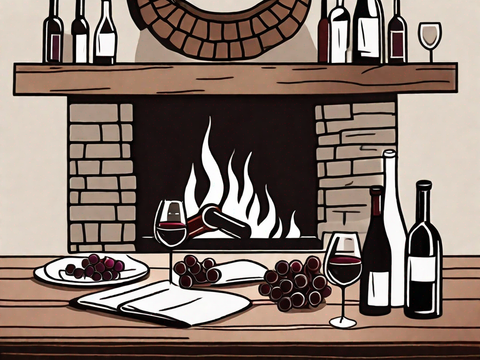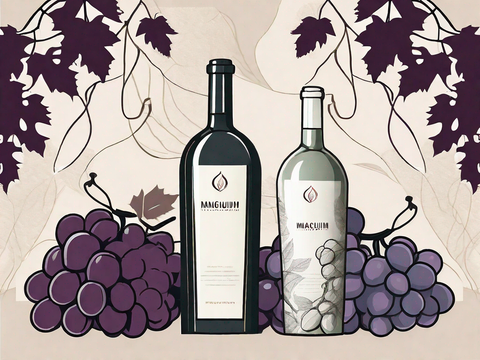Sparkling wine has long been associated with celebration and luxury. While many people are familiar with the renowned Champagne from France, the world of sparkling wine extends far beyond the borders of Europe. In recent years, American sparkling wine has emerged as a force to be reckoned with, gaining recognition for its exceptional quality and unique character. In this article, we will delve into the world of American sparkling wine, exploring its basics, history, key regions, notable producers, and tasting and pairing tips.
Understanding the Basics of Sparkling Wine
Before we dive into the specifics of American sparkling wine, it's important to understand the basics of this effervescent beverage. Sparkling wine is made using the traditional method, also known as the méthode champenoise. This labor-intensive process involves a second fermentation in the bottle, resulting in those delightful bubbles that dance on your palate.
The primary grape varieties used in American sparkling wine are Chardonnay, Pinot Noir, and Pinot Meunier, with each contributing its own unique characteristics to the final blend. The level of sweetness in sparkling wine can vary, from bone-dry brut to lusciously sweet demi-sec, catering to a wide range of preferences.
The Process of Making Sparkling Wine
The process of making sparkling wine begins with harvesting grapes at optimal ripeness. After pressing, the juice undergoes fermentation, producing a still base wine. The wine is then bottled with a mixture called "liqueur de tirage," which contains yeast and a small amount of sugar. This triggers the second fermentation, during which carbon dioxide is trapped in the bottle, creating the signature bubbles.
After several months of aging on the lees (the spent yeast cells), the wine undergoes a process called riddling, where the bottles are gradually angled downwards, encouraging the yeast sediments to collect in the neck. The neck of the bottle is then frozen, and the frozen yeast plug is disgorged, followed by the addition of a dosage, a mixture of wine and sugar, which determines the sweetness level of the finished wine.
Different Types of Sparkling Wine
American sparkling wine encompasses a range of styles to suit diverse palates. Blanc de Blancs, made exclusively from Chardonnay grapes, offers crisp acidity and delicate citrus flavors. On the other hand, Blanc de Noirs, crafted from Pinot Noir and Pinot Meunier, showcases richer fruit profiles and robust structure. Rosé sparkling wine, boasting its distinct pink hue, can be made by either blending red and white wines or allowing the grape skins to remain in contact with the juice during maceration.
The History of American Sparkling Wine
The history of American sparkling wine is woven with fascinating stories of perseverance, innovation, and passionate winemakers. While sparkling wine production in the United States dates back to the early 19th century, it wasn't until much later that it gained significant recognition.
Early Beginnings of Sparkling Wine in America
In the early 1800s, a German winemaker named Johann Schramm planted the first vineyards dedicated to sparkling wine in California's Napa Valley. However, it was a Hungarian-born winemaker, Agoston Haraszthy, who truly made a mark in the history of American sparkling wine. Haraszthy established Buena Vista Winery in Sonoma in 1857, pioneering the production of high-quality sparkling wine in the region.
Unfortunately, due to challenges such as phylloxera infestation, Prohibition, and market preferences for still wine, the production of American sparkling wine faced significant setbacks. It wasn't until the 1960s that a new wave of winemakers revitalized the industry, embarking on a journey to redefine American sparkling wine.
Evolution and Growth of the Sparkling Wine Industry
The past few decades have witnessed remarkable growth in the American sparkling wine industry. Today, countless wineries across the country are dedicated to crafting exceptional sparkling wines that can rival their European counterparts. Improved viticultural practices, advancements in winemaking techniques, and a strong commitment to quality have contributed to this renaissance.
Key Regions for American Sparkling Wine
When it comes to American sparkling wine, certain regions have proven to be particularly well-suited for its production. Let's take a closer look at two of the most prominent ones: California's Napa Valley and emerging regions across the country.
California's Sparkling Wine Scene
California's Napa Valley, with its favorable climate and diverse terroir, has become a hotbed for American sparkling wine. Wineries such as Schramsberg Vineyards, Domaine Carneros, and Iron Horse Vineyards have gained international acclaim for their exceptional sparkling wines, which showcase the region's terroir in each delightful bubble.
Emerging Regions for Sparkling Wine
While California remains a pioneer in American sparkling wine production, other regions across the country are also proving their mettle. Oregon's Willamette Valley and New York's Finger Lakes region have garnered attention for their cool-climate sparkling wines, characterized by vibrant acidity and nuanced flavors.
Notable American Sparkling Wine Producers
American sparkling wine owes its rising reputation to a talented group of producers, both established pioneers and up-and-coming stars. Let's explore some of the notable names shaping the American sparkling wine landscape.
Pioneers in the American Sparkling Wine Industry
Schramsberg Vineyards, founded in 1965, played a pivotal role in reviving the American sparkling wine industry. Their dedication to quality and traditional winemaking techniques has resulted in stellar wines that have been served at presidential inaugurations and state dinners.
Iron Horse Vineyards, established in the 1970s, has also made a significant impact. With their breathtaking estate nestled in Green Valley, Sonoma, they craft sparkling wines that embody elegance and finesse, capturing the essence of their vineyard's terroir.
Rising Stars in American Sparkling Wine
As the American sparkling wine scene continues to grow, a new generation of winemakers is making waves with their innovative approaches. J. Christopher Wines from Oregon and Ravines Wine Cellars from New York's Finger Lakes region are just two examples of producers pushing the boundaries and creating exciting new expressions of American sparkling wine.
Tasting and Pairing American Sparkling Wine
Now that we've explored the world of American sparkling wine, it's time to indulge in the sensory pleasures it offers.
How to Taste Sparkling Wine
When tasting sparkling wine, it's important to use proper glassware, such as a flute or a tulip-shaped glass, to preserve the effervescence and showcase the aromas. Start by observing the bubbles and the color of the wine, then take a moment to inhale the enticing aromatics. On the palate, pay attention to the balance of acidity, the texture of the bubbles, and the flavors that unfurl with each sip.
Food Pairings for American Sparkling Wine
American sparkling wine's versatility makes it an excellent companion to a wide range of foods. Its refreshing acidity and effervescence cleanse the palate and complement an array of dishes. For a classic pairing, indulge in oysters or caviar. Cheese lovers can explore the pairing possibilities with creamy Brie or tangy goat cheese. When it comes to main courses, consider pairing sparkling wine with seafood, grilled vegetables, or even fried chicken for a delightful contrast.
As you embark on your journey into the world of American sparkling wine, you'll discover a vibrant and dynamic landscape filled with exceptional wines that capture the essence of their regions and winemakers' passion. Raise a glass, celebrate, and toast to the ongoing exploration and enjoyment of American sparkling wine!




